Enriched Breads

Enriched breads, such as the vegan ones here, are any bread that has additional flavor and texture enhancing ingredients other than flour, water, leavening agents and salt. In these flavorful bread recipes, the dough is enriched with ingredients such as agave syrup, vegetable oil and other flavorings. Enriched breads are baked at lower temperatures compared to hearth breads and are usually baked in a loaf pan, sliced and often used for sandwiches.
 guest
2
guest
2
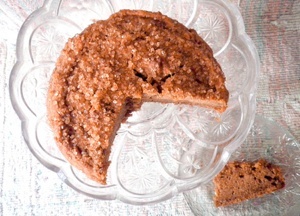 I glanced over at my fruit basket yesterday and found four moldy looking apples at the bottom. They had been languishing there for over a week, with no one paying them any attention. Now, I'm a bit of a purist with my apples. I only like them tart and crunchy with faint green veins running through their flesh. Bruised apples with brown spots go straight on my list of foods I most hate to eat. Still, something had to be done with those apples, and without much of a plan, I peeled, cored, and chopped them up.
I glanced over at my fruit basket yesterday and found four moldy looking apples at the bottom. They had been languishing there for over a week, with no one paying them any attention. Now, I'm a bit of a purist with my apples. I only like them tart and crunchy with faint green veins running through their flesh. Bruised apples with brown spots go straight on my list of foods I most hate to eat. Still, something had to be done with those apples, and without much of a plan, I peeled, cored, and chopped them up. Then I spied a jar full of demerara sugar that I'd bought recently, and inspiration took form. I decided I'd bake an apple bread. The principle would be the same as banana bread, only since apple has a higher water content, I could consider lowering the amount of fat in my recipe, and under bake slightly, so my cake would remain moist. A small quantity of vinegar provides just enough acid for leavening, and the baking soda helps it rise. This bread bakes up dense.
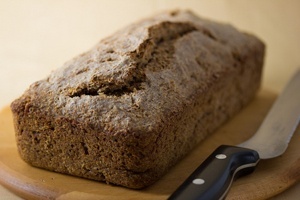 Traditional flour is ground endosperm powder which is the result of the flour mill removing most of the hard pieces and hence, nutrition from the wheat berry. I'm a huge fan of whole sprouted grains because they're more flavorful and contain significantly more nutrients than bread made with traditional flour. This Flourless Sprouted Whole Wheat Bread recipe utilizes sprouted wheat berries that are then ground into a purée. This requires a substantially hardy food processor. If you're not sure if your food processor is powerful enough, look on the bottom. It should say at least 6.5 Amps or "6.5 A".
Traditional flour is ground endosperm powder which is the result of the flour mill removing most of the hard pieces and hence, nutrition from the wheat berry. I'm a huge fan of whole sprouted grains because they're more flavorful and contain significantly more nutrients than bread made with traditional flour. This Flourless Sprouted Whole Wheat Bread recipe utilizes sprouted wheat berries that are then ground into a purée. This requires a substantially hardy food processor. If you're not sure if your food processor is powerful enough, look on the bottom. It should say at least 6.5 Amps or "6.5 A". This bread was difficult to design due to the nature of the wheat berry. This hardy seed contains the germ which is the heart and soul of the seed. The germ is the embryo of the plant in its dormant state. It's accompanied by the starchy endosperm which acts as fuel for the germ when it sprouts or germinates. This package is encased in a firm fibrous shell called the bran. This protects the seed kind of like an egg shell protects an egg.
 “See those bananas over there?”, I asked, tilting my head towards the end of the aisle at the health food store. “I’ll buy fifteen of ‘em for half price”, I suggested confidently. The cashier paused for a moment, not knowing whether to believe me. Why would anyone want to buy bananas that were almost more suitable for the compost bin than the kitchen for any price? “Sure”, he sighed. He knew they were garbage unless I took them in. I laughed to myself when I realized how excited I was to buy bananas that most people wouldn’t even think of eating. I started to feel bad about not liberating the others but I had to get home; there was work to do! How cool would it be to peel the bananas, purée them and slow cook them into a thick syrup to use as a base for fruit sweetened banana bread? Finally, something to do with all those bananas laying around in your freezer!
“See those bananas over there?”, I asked, tilting my head towards the end of the aisle at the health food store. “I’ll buy fifteen of ‘em for half price”, I suggested confidently. The cashier paused for a moment, not knowing whether to believe me. Why would anyone want to buy bananas that were almost more suitable for the compost bin than the kitchen for any price? “Sure”, he sighed. He knew they were garbage unless I took them in. I laughed to myself when I realized how excited I was to buy bananas that most people wouldn’t even think of eating. I started to feel bad about not liberating the others but I had to get home; there was work to do! How cool would it be to peel the bananas, purée them and slow cook them into a thick syrup to use as a base for fruit sweetened banana bread? Finally, something to do with all those bananas laying around in your freezer!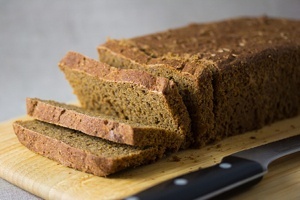 After falling in love with rye breads I became fascinated with developing a bread containing 100 percent rye. I knew that taking all of the wheat flour out of a bread recipe would wreak havoc on the end result and a high-rising crusty bread would not be obtainable. This is because wheat flour is unique in that it contains two proteins in the wheat endosperm called glutenin and gliadin. When these proteins hydrate and undergo friction, they unravel like balls of yarn, bind together into sticky strands and form a structure building network. This elastic web of protein holds in air bubbles during leavening and acts as a structure builder after the bread cools, resulting in a high-rising, fluffy, springy loaf.
After falling in love with rye breads I became fascinated with developing a bread containing 100 percent rye. I knew that taking all of the wheat flour out of a bread recipe would wreak havoc on the end result and a high-rising crusty bread would not be obtainable. This is because wheat flour is unique in that it contains two proteins in the wheat endosperm called glutenin and gliadin. When these proteins hydrate and undergo friction, they unravel like balls of yarn, bind together into sticky strands and form a structure building network. This elastic web of protein holds in air bubbles during leavening and acts as a structure builder after the bread cools, resulting in a high-rising, fluffy, springy loaf.
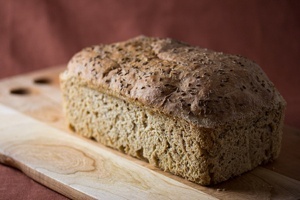 A tough of sugar takes the edge off the bitterness of the rye in this Easy Vegan Rye Bread recipe. Molasses has been added to increase the overall richness of the rye flavor and caraway seeds adds an interesting layer subtle spicy cool to the loaf. Feel free to experiment with these additions and change them if you prefer. The loaf will still turn out roughly the same.
A tough of sugar takes the edge off the bitterness of the rye in this Easy Vegan Rye Bread recipe. Molasses has been added to increase the overall richness of the rye flavor and caraway seeds adds an interesting layer subtle spicy cool to the loaf. Feel free to experiment with these additions and change them if you prefer. The loaf will still turn out roughly the same.Initially I was intrigued by the flavor of rye breads but intimidated by baking them. How was I supposed to bake flavorful, crusty loafs with most of the leavening-enhancing gluten out of the picture? A little research found that although rye flour contains about the same amount of protein than regular flour, most of this protein isn't from glutenin and gliadin, the two protein compounds that unravel and combine to create gluten when water is added and the mixture is kneaded. What rye flour does contain though are natural gums called pentosans which absorb about 16 times their weight in water. This is the puzzle piece of how these breads are crafted.
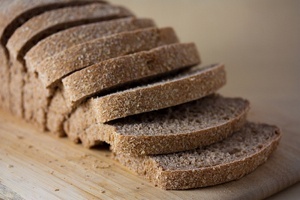 This Vegan No Knead Whole Wheat Sandwich Bread is now my go-to vegan bread recipe because it's simple to make and is a great example of how wet doughs can create wonderfully light and spongy breads. The higher water content allows the gliadin and glutenin in the flour to align into tight gluten bonds over time so you can forget about all that kneading drama. The result is a fluffy, chewy loaf that's perfect for sandwiches. Feel free to use this bread as a starting point and substitute a ½ cup of the flour for things like wheat germ, wheat bran or oat bran. It's important to note that due to the wetness of this dough it's only suitable for baking in a loaf pan.
This Vegan No Knead Whole Wheat Sandwich Bread is now my go-to vegan bread recipe because it's simple to make and is a great example of how wet doughs can create wonderfully light and spongy breads. The higher water content allows the gliadin and glutenin in the flour to align into tight gluten bonds over time so you can forget about all that kneading drama. The result is a fluffy, chewy loaf that's perfect for sandwiches. Feel free to use this bread as a starting point and substitute a ½ cup of the flour for things like wheat germ, wheat bran or oat bran. It's important to note that due to the wetness of this dough it's only suitable for baking in a loaf pan.
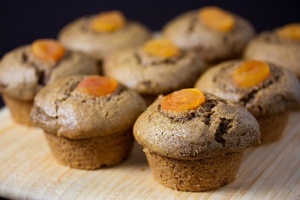 The sweetness of apricots and the earthiness of 100% rye flour complement each other, especially when accompanied by molasses, cardamom and espresso powder in this Vegan Apricot Rye Muffin recipe. Rye flour contains a low amount of gluten compared to wheat based flour so in order to enhance binding, the batter is mixed for 1 minute to allow the starches in the flour to become activated. The pectin in the apricot preserves also acts wonderfully as a binder in these vegan muffins.
The sweetness of apricots and the earthiness of 100% rye flour complement each other, especially when accompanied by molasses, cardamom and espresso powder in this Vegan Apricot Rye Muffin recipe. Rye flour contains a low amount of gluten compared to wheat based flour so in order to enhance binding, the batter is mixed for 1 minute to allow the starches in the flour to become activated. The pectin in the apricot preserves also acts wonderfully as a binder in these vegan muffins.
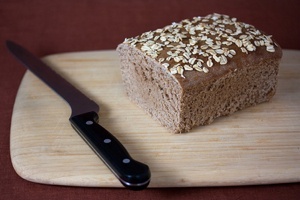 This Wild Yeasted Wheat Bread recipe, also known as sourdough bread uses a wild yeast sponge to leaven the dough, creating a multitude of complex flavor compounds in the process. Be sure to read and cultivate your wild yeast starter and sponge before starting this vegan bread. Sandwich breads baked in loaf pans are usually baked at lower temperatures around 350F (177C) to 375F (191C) and 'enriched' with things like sweeteners, oil and extra salt. Artisan breads formed and baked without loaf pans are baked at higher temperatures around 400F (204C) to 475F (246C) where the heat allows extra flavors to be developed. Taking this into account, your bread recipe and baking process will be slightly different depending on which method you choose. This recipe gives you options for both styles.
This Wild Yeasted Wheat Bread recipe, also known as sourdough bread uses a wild yeast sponge to leaven the dough, creating a multitude of complex flavor compounds in the process. Be sure to read and cultivate your wild yeast starter and sponge before starting this vegan bread. Sandwich breads baked in loaf pans are usually baked at lower temperatures around 350F (177C) to 375F (191C) and 'enriched' with things like sweeteners, oil and extra salt. Artisan breads formed and baked without loaf pans are baked at higher temperatures around 400F (204C) to 475F (246C) where the heat allows extra flavors to be developed. Taking this into account, your bread recipe and baking process will be slightly different depending on which method you choose. This recipe gives you options for both styles.
 Renoodle
12
Renoodle
12
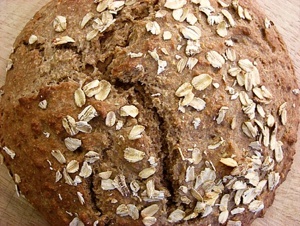 I veganized this Oatmeal Whole Wheat Quick Bread from a recipe found here. All I can say is WOW! Moist, full of texture, earthy and oh so delicious.
I veganized this Oatmeal Whole Wheat Quick Bread from a recipe found here. All I can say is WOW! Moist, full of texture, earthy and oh so delicious.
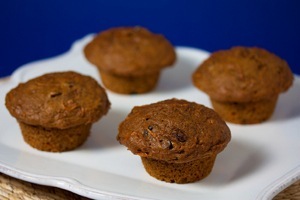 Carrot cake is my all-time favorite dessert so I adapted it into a heartier quick bread in the form of this Vegan Carrot Cake Muffin recipe so I could justify having it for breakfast. It's pointless to resist carrot cake goodness in it's new quick bread form so don't even try. A dollop of almond butter on top contrasts nicely with carrot cake flavor and adds extra nutritious oomph to power your day of world domination.
Carrot cake is my all-time favorite dessert so I adapted it into a heartier quick bread in the form of this Vegan Carrot Cake Muffin recipe so I could justify having it for breakfast. It's pointless to resist carrot cake goodness in it's new quick bread form so don't even try. A dollop of almond butter on top contrasts nicely with carrot cake flavor and adds extra nutritious oomph to power your day of world domination.
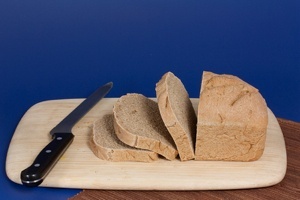 There's nothing quite like home made bread. This hearty Easy Vegan Wheat Bread recipe is easy to whip up if you have a few hours and it's really simple. In bread baking, longer rise cycles at lower temperatures usually result in more flavor compounds that are generated due to the yeast extracting and break down more starches in the flour and converting them into sugars which will then get caramelized during baking. Some doughs call for an overnight rise in the refrigerator so optimum flavor can be developed. In this vegan loaf you have the option of doing an overnight slow rise in the refrigerator or a regular rise. The two first rise cycle is for the main fermentation of the dough where the yeast eats the most sugars and rises the bread with CO2. The last rise is called proofing in where the dough rises after it's been molded into it's desired shape or placed in it's specific mold.
There's nothing quite like home made bread. This hearty Easy Vegan Wheat Bread recipe is easy to whip up if you have a few hours and it's really simple. In bread baking, longer rise cycles at lower temperatures usually result in more flavor compounds that are generated due to the yeast extracting and break down more starches in the flour and converting them into sugars which will then get caramelized during baking. Some doughs call for an overnight rise in the refrigerator so optimum flavor can be developed. In this vegan loaf you have the option of doing an overnight slow rise in the refrigerator or a regular rise. The two first rise cycle is for the main fermentation of the dough where the yeast eats the most sugars and rises the bread with CO2. The last rise is called proofing in where the dough rises after it's been molded into it's desired shape or placed in it's specific mold.
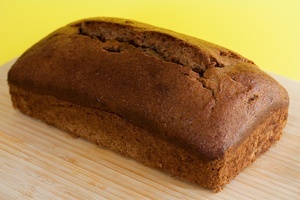 The more I use yeast instead of baking powder for quick breads such as Yeasted Vegan Banana Bread, the more I notice that yeasted breads produce far better flavor results. How did we get into this bad habit of chemically leavening our sweet breads with baking powder and baking soda? One word: convenience. Yeasted breads take about 3 times longer to make because we have to wait for the yeast to do it's thing. Yeast leavened breads are usually considerably more flavorful than chemically leavened breads because as the yeast ferments and spits out C02 that rises the bread, it also produces a multitude of complex flavor compounds. This is not the case with chemically leavened breads where few flavor byproducts are produced during the chemical reaction between acid and alkalne that produces the C02. Yeasted Vegan Banana Bread is now my go-to vegan banana bread recipe.
The more I use yeast instead of baking powder for quick breads such as Yeasted Vegan Banana Bread, the more I notice that yeasted breads produce far better flavor results. How did we get into this bad habit of chemically leavening our sweet breads with baking powder and baking soda? One word: convenience. Yeasted breads take about 3 times longer to make because we have to wait for the yeast to do it's thing. Yeast leavened breads are usually considerably more flavorful than chemically leavened breads because as the yeast ferments and spits out C02 that rises the bread, it also produces a multitude of complex flavor compounds. This is not the case with chemically leavened breads where few flavor byproducts are produced during the chemical reaction between acid and alkalne that produces the C02. Yeasted Vegan Banana Bread is now my go-to vegan banana bread recipe.
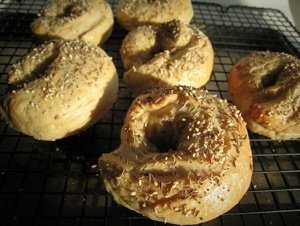 I know that one day I won't have access to my favorite bagel place on Bedford ave in Brooklyn on my way home from the bars to grab a late night snack. This Vegan Everything Bagel recipe will hopefully keep me content in those times. Enjoy these vegan bagels with Tofutti cream cheese, Creamy Vegan Cashew Cream Cheese, my more involved Vegan Cashew Cream Cheese or whatever else floats your fancy. I've designed these bagels in the authentic NY style which uses barley malt, also known as malted barley. Barley malt is highly recommended but if you don't have it just use an additional one-half Tablespoon sugar in its place. Be sure to allow ample time for this recipe- it takes about two hours. If you live further than two hours away from New York City, this recipe will be easier than flying there for the flavor.
I know that one day I won't have access to my favorite bagel place on Bedford ave in Brooklyn on my way home from the bars to grab a late night snack. This Vegan Everything Bagel recipe will hopefully keep me content in those times. Enjoy these vegan bagels with Tofutti cream cheese, Creamy Vegan Cashew Cream Cheese, my more involved Vegan Cashew Cream Cheese or whatever else floats your fancy. I've designed these bagels in the authentic NY style which uses barley malt, also known as malted barley. Barley malt is highly recommended but if you don't have it just use an additional one-half Tablespoon sugar in its place. Be sure to allow ample time for this recipe- it takes about two hours. If you live further than two hours away from New York City, this recipe will be easier than flying there for the flavor.
 This Vegan Blueberry Beetnik Muffin recipe takes advantage of baked beets which harbor wonderful butter caramel flavors when their sugars caramelize. The vegan muffins are then complimented by the tartness of blueberries and just the right ratio of whole wheat flour and all-purpose flour. Lemon juice enhances flavor while allowing the beet purée to retain its vibrant reddish color during baking. This is because acids reduce the oxidation of plant-based compounds called anthocyanins, which are responsible for the red color in foods like beets and raspberries.
This Vegan Blueberry Beetnik Muffin recipe takes advantage of baked beets which harbor wonderful butter caramel flavors when their sugars caramelize. The vegan muffins are then complimented by the tartness of blueberries and just the right ratio of whole wheat flour and all-purpose flour. Lemon juice enhances flavor while allowing the beet purée to retain its vibrant reddish color during baking. This is because acids reduce the oxidation of plant-based compounds called anthocyanins, which are responsible for the red color in foods like beets and raspberries.
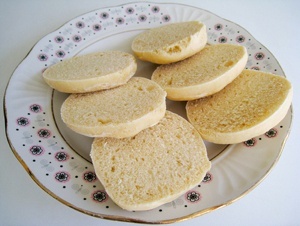 This Vegan English Muffin recipe features just a touch of lemon juice and sugar to enhance its yeast-induced flavors. They're awesome fresh out of the toaster with a little Vegan Butter, jam or whatever your preferred muffin topping is. I've been known to use these as burger buns too. They're not loaded with preservatives and dough conditioners like their store-bought cousins but they'll still keep in the freezer stored in a plastic freezer bag for several months.
This Vegan English Muffin recipe features just a touch of lemon juice and sugar to enhance its yeast-induced flavors. They're awesome fresh out of the toaster with a little Vegan Butter, jam or whatever your preferred muffin topping is. I've been known to use these as burger buns too. They're not loaded with preservatives and dough conditioners like their store-bought cousins but they'll still keep in the freezer stored in a plastic freezer bag for several months.

